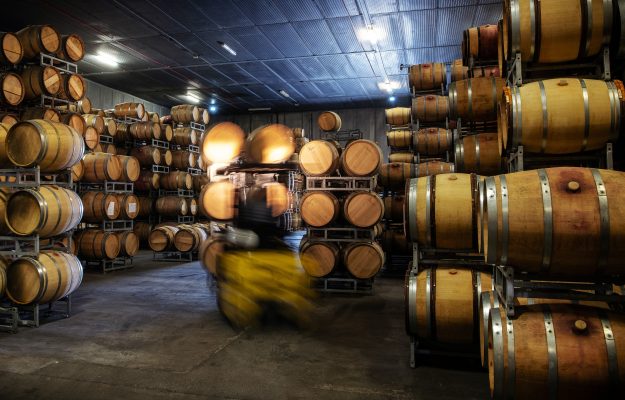Although consumption is on a decline, and the economy is struggling to restart, wine stocks in Italian wineries, as of October 7, 2020, are stable compared to the same period last year. There are 35.9 million hectoliters of wine, 10.4 million hectoliters of musts and 4.7 million hectoliters of new wine still in fermentation, as “Cantina Italia” reported from the latest update by the Department of the Central Inspectorate of Quality Protection and Fraud Repression for agro-food products of the Ministry of Agriculture. On September 30, 2019 there was a reduction of 2.8% in wine stocks, an increase in musts (+ 86.8%) and, above all, wines in fermentation, which is normal at this time of year (+ 253%). On the other hand, stocks were slightly up compared to September 30, 2020 (+ 0.2%)and, in the same period, stocks of musts were up +41.3% and wines in fermentation up +67.9%.
Over 58% of the wine is physically in stock in the Northern Italian regions. The Veneto Region alone holds 23.8% of all national wine, mainly because of the significant contribution of wine stocks in the provinces of Verona (10%) and Treviso (8.6%). 54% of the wine is PDO, and there is a prevalence of reds (59%). Instead, 25.4% of the wine is PGI, and also in this case, a prevalence of reds (59.9%), while the varietal wines make up just 1.6% of the total. The remaining 19.0% is made up of other types of wines. Notwithstanding the large number of DO (525), 10 denominations make up 38.8% of the total, and the top 20 denominations represent more than half of the total DO (55.5%).
The average prices of wines with appellation, on the other hand, have fallen significantly. In September, the latest Italian Institute of Services for agro-food markets, ISMEA, prices revealed (excluding VAT and free-cellar) that the trend, excepting a few isolated cases, is a generalized drop in prices, which are down on average -10.8%. The price fall of Barolo,on the market at 410 euros per hectoliter at September 30th, was 38.3% less than in September 2019;Barbarescois also falling: 400 euros per hectoliter, 25.2% less than a year ago and Barbera d’Albais at 180 euros. In Veneto,Amarone della Valpolicella has limited the damages, dropping only -6.5%, and its price settling at 725 euros per hectoliter. The decline inValpolicellaandValpolicella Classicois, however, more significant, at 130 and 150 euros respectively. Data for September 2019 is missing, but the August survey stood at 165 and 180 euros.
Continuing down the Peninsula, even the Tuscan red wines have to deal with the challenges of the market, and with the relative and consequent drops in prices, which are very different between one denomination and another. Brunello di Montalcino, in the last 12 months, has dropped -16.6%, settling at 905 euros per hectoliter. Chianti has lost -11.1%, at 100 euros, Chianti Classico has lost only -7.3%, settling at the price 252 euros, and Nobile di Montepulciano did even better, at 275 euros per hectoliter, -3.5% less than last year. Despite the negative trend, Montepulciano d’Abruzzo was stable, at 66.87 euros (-0.9%). One of the very few wines in contrast to this trend is Primitivo di Manduria, on the bulk market at 104 euros per hectoliter, up +7.2%. Sicilia DOC did even better and is quoted at 120 euros, +25.7% more compared to September 2019.
As far as white wines are concerned, the situation is not quite so bad.Here too, a Piedmont appellation registered the worst decrease: Roero Arneis, down -27.7%, to 170 euros per hectoliter. Conegliano Valdobbiadene Prosecco did not do well either, and dropped to 197.5 euros, -19.4%, and the same for Prosecco, which lost -18.7%, at 162.5 euros. The white wine, Soave, symbol of Veneto, on the market at 80 euros, is running at two speeds: 13% less than 12 months ago, but it is growing in its superior version, Soave Classico: + 4.3% to 120 euros per hectoliter. Pinot Grigio delle Venezie has lost 21.7%, returning to the levels of the first half of 2019, before the end of the year boom, at 90 euros per hectoliter.
Continuing on, Vernaccia di San Gimignano has limited the damage to 125 euros per hectoliter on the bulk market (-7.7%). Orvieto, quoted at 90 euros, has lost -10%, while Vermentino di Sardegna earned +17.2%, reaching 170 euros per hectoliter. Finally, Franciacorta and Trentodoc, which deserve a separate comment. The two bubbles that symbolize the Italian classic method, as such are less susceptible to price fluctuations, because they have the tools to deal with market dynamics, and therefore always stay more or less stable.
These price quotes, as we have always said, are to be taken into consideration as a pure indication, because prices can vary, even significantly, during the negotiation phase. Prices depend on the quality of the individual lots, vintages, market trends as well as on the demand and offer. In any case, these quotes narrate, once again, the complexity of Italian wine, which is often talked about as unique, but instead it comprises the myriad of companies that are very different from each other in terms of value and market dynamics.
Copyright © 2000/2025
Contatti: info@winenews.it
Seguici anche su Twitter: @WineNewsIt
Seguici anche su Facebook: @winenewsit
Questo articolo è tratto dall'archivio di WineNews - Tutti i diritti riservati - Copyright © 2000/2025








































































































































































































